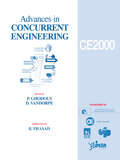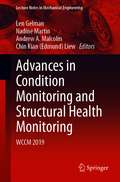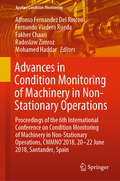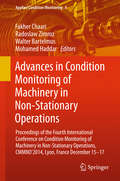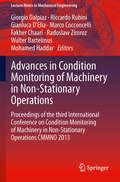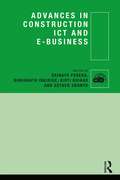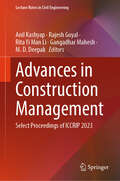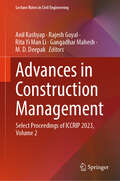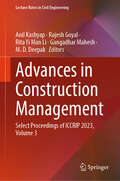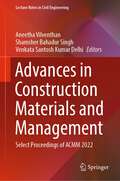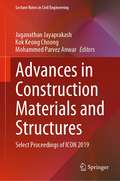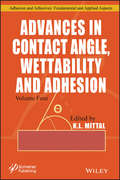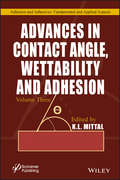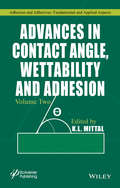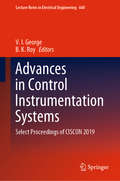- Table View
- List View
Advances in Concurrent Engineering: CE00 Proceedings
by Biren PrasadThis book is a collection of papers presented at the 7th ISPE International Conference on Concurrent Engineering (CE): Research and Applications. The papers deal with different topics providing information on information modelling, CE in virtual environment, and standards in CE.
Advances in Condition Monitoring and Structural Health Monitoring: WCCM 2019 (Lecture Notes in Mechanical Engineering)
by Len Gelman Nadine Martin Andrew A. Malcolm Chin Kian Edmund LiewThis book comprises the selected contributions from the 2nd World Congress on Condition Monitoring (WCCM 2019), held in Singapore in December 2019. The contents focus on digitalisation for condition monitoring with the emergence of the fourth industrial revolution (Industry 4.0) and the Industrial Internet-of-Things (IIoT). The book covers latest research findings in the areas of condition monitoring, structural health monitoring, and non-destructive testing which are relevant for many sectors including aerospace, automotive, civil, oil and gas, marine, and manufacturing industries. Different monitoring systems and non-destructive testing methods are discussed to avoid failures, increase lifespans, and reduce maintenance costs of equipment and machinery. The broad scope of the contents will make this book interesting for academics and professionals working in the areas of non-destructive evaluation and condition monitoring.
Advances in Condition Monitoring of Machinery in Non-Stationary Operations: Proceedings of the 5th International Conference on Condition Monitoring of Machinery in Non-stationary Operations, CMMNO’2016, 12–16 September 2016, Gliwice, Poland (Applied Condition Monitoring #9)
by Fakher Chaari Mohamed Haddar Radoslaw Zimroz Walter Bartelmus Anna TimofiejczukThis book presents the processing of the third edition of the Condition Monitoring of Machinery in Non-Stationary Operations (CMMNO13), which was held in Ferrara, Italy. This yearly event merges an international community of researchers who met - in 2011 in Wroclaw (Poland) and in 2012 in Hammamet (Tunisia) - to discuss issues of diagnostics of rotating machines operating in complex motion and/or load conditions. The growing interest of the industrial world on the topics covered by the CMMNO13 involves the fields of packaging, automotive, agricultural, mining, processing and wind machines in addition to that of the systems for data acquisition. The participation of speakers and visitors from industry makes the event an opportunity for immediate assessment of the potential applications of advanced methodologies for the signal analysis. Signals acquired from machines often contain contributions from several different components as well as noise. Therefore, the major challenge of condition monitoring is to point out the signal content that is related to the state of the monitored component particularly in non-stationary conditions.
Advances in Condition Monitoring of Machinery in Non-Stationary Operations: Proceedings of the 6th International Conference on Condition Monitoring of Machinery in Non-Stationary Operations, CMMNO’2018, 20-22 June 2018, Santander, Spain (Applied Condition Monitoring #15)
by Fakher Chaari Mohamed Haddar Radoslaw Zimroz Alfonso Fernandez Del Rincon Fernando Viadero RuedaThis book is aimed at researchers, industry professionals and students interested in the broad ranges of disciplines related to condition monitoring of machinery working in non-stationary conditions. Each chapter, accepted after a rigorous peer-review process, reports on a selected, original piece of work presented and discussed at the International Conference on Condition Monitoring of Machinery in Non-stationary Operations, CMMNO’2018, held on June 20 – 22, 2018, in Santander, Spain. The book describes both theoretical developments and a number of industrial case studies, which cover different topics, such as: noise and vibrations in machinery, conditioning monitoring in non-stationary operations, vibro-acoustic diagnosis of machinery, signal processing, application of pattern recognition and data mining, monitoring and diagnostic systems, faults detection, dynamics of structures and machinery, and mechatronic machinery diagnostics.
Advances in Condition Monitoring of Machinery in Non-Stationary Operations: Proceedings of the Fourth International Conference on Condition Monitoring of Machinery in Non-Stationary Operations, CMMNO'2014, Lyon, France December 15-17 (Applied Condition Monitoring #4)
by Fakher Chaari Mohamed Haddar Radoslaw Zimroz Walter BartelmusThe book provides readers with a snapshot of recent research and technological trends in the field of condition monitoring of machinery working under a broad range of operating conditions. Each chapter, accepted after a rigorous peer-review process, reports on an original piece of work presented and discussed at the 4th International Conference on Condition Monitoring of Machinery in Non-stationary Operations, CMMNO 2014, held on December 15-16, 2014, in Lyon, France. The contributions have been grouped into three different sections according to the main subfield (signal processing, data mining or condition monitoring techniques) they are related to. The book includes both theoretical developments as well as a number of industrial case studies, in different areas including, but not limited to: noise and vibration; vibro-acoustic diagnosis; signal processing techniques; diagnostic data analysis; instantaneous speed identification; monitoring and diagnostic systems; and dynamic and fault modeling. This book not only provides a valuable resource for both academics and professionals in the field of condition monitoring, it also aims at facilitating communication and collaboration between the two groups.
Advances in Condition Monitoring of Machinery in Non-Stationary Operations: Proceedings of the third International Conference on Condition Monitoring of Machinery in Non-Stationary Operations CMMNO 2013 (Lecture Notes in Mechanical Engineering #9)
by Fakher Chaari Mohamed Haddar Radoslaw Zimroz Walter Bartelmus Giorgio Dalpiaz Riccardo Rubini Gianluca D'Elia Marco CocconcelliThis book presents the processing of the third edition of the Condition Monitoring of Machinery in Non-Stationary Operations (CMMNO13), which was held in Ferrara, Italy. This yearly event merges an international community of researchers who met - in 2011 in Wroclaw (Poland) and in 2012 in Hammamet (Tunisia) - to discuss issues of diagnostics of rotating machines operating in complex motion and/or load conditions. The growing interest of the industrial world on the topics covered by the CMMNO13 involves the fields of packaging, automotive, agricultural, mining, processing and wind machines in addition to that of the systems for data acquisition. The participation of speakers and visitors from industry makes the event an opportunity for immediate assessment of the potential applications of advanced methodologies for the signal analysis. Signals acquired from machines often contain contributions from several different components as well as noise. Therefore, the major challenge of condition monitoring is to point out the signal content that is related to the state of the monitored component particularly in non-stationary conditions.
Advances in Construction ICT and e-Business
by Srinath Perera Kirti Ruikar Bingunath Ingirige Esther ObonyoThis internationally conducted study of the latest construction industry practices addresses a broad range of Information and Communication Technology applications. Drawing on research conducted in the US and UK, this book presents the state of the art of various ebusiness processes, and examines BIM, virtual environments and mobile technologies. Innovation is a theme that runs throughout this book, so in addition to the direct impact of these new technical achievements, it also considers the management styles that helped them to emerge. Examples from industry are illustrated with case studies and presented alongside research from some of the best known academics in this field. This book is essential reading for all advanced students and researchers interested in how ICT is changing construction management and the construction industry.
Advances in Construction Management: Select Proceedings of ACMM 2021 (Lecture Notes in Civil Engineering #191)
by K. Gunasekaran Lee Yee Loon Muthulingam SubramaniyanThis book presents the select proceedings of the International Conference on Advances in Construction Materials and Management (ACMM 2021). It discusses the recent innovations towards construction management, building technology and new materials in practice in civil engineering. Various topics covered include architecture and urban planning, smart materials and structures, GIS in construction application, transportation materials and engineering, geotechnical applications in construction, energy and sustainability, green building technologies and materials and construction management. The book will be useful for beginners, researchers and professionals working in the area of civil engineering.
Advances in Construction Management: Select Proceedings of ICCRIP 2023 (Lecture Notes in Civil Engineering #238)
by Anil Kashyap Rita Yi Man Li Rajesh Goyal Gangadhar Mahesh M. D. DeepakThis book presents the select proceedings of the 7th International Conference on Construction, Real Estate, Infrastructure, and Project Management (ICCRIP 2023) and explores recent and innovative developments in all aspects of the CRIP sector. The book covers various issues in construction management, advancements in construction technologies and materials, sustainable construction practices, managerial issues in the CRIP sector, construction 4.0, project management, real estate and urban planning, energy, environment and sustainability. The book will be useful for researchers and professionals involved in construction management, civil engineering and related fields.
Advances in Construction Management: Select Proceedings of ICCRIP 2023, Volume 2 (Lecture Notes in Civil Engineering #601)
by Anil Kashyap Rita Yi Man Li Rajesh Goyal Gangadhar Mahesh M. D. DeepakThis book presents the select proceedings of the 7th International Conference on Construction, Real Estate, Infrastructure, and Project Management (ICCRIP 2023) and explores recent and innovative developments in all aspects of the CRIP sector. The book covers various issues in construction management, advancements in construction technologies and materials, sustainable construction practices, managerial issues in the CRIP sector, construction 4.0, project management, real estate and urban planning, energy, environment and sustainability. The book will be useful for researchers and professionals involved in construction management, civil engineering and related fields.
Advances in Construction Management: Select Proceedings of ICCRIP 2023, Volume 3 (Lecture Notes in Civil Engineering #618)
by Anil Kashyap Rita Yi Man Li Rajesh Goyal Gangadhar Mahesh M. D. DeepakThis book presents the select proceedings of the 7th International Conference on Construction, Real Estate, Infrastructure, and Project Management (ICCRIP 2023) and explores recent and innovative developments in all aspects of the CRIP sector. The book covers various issues in construction management, advancements in construction technologies and materials, sustainable construction practices, managerial issues in the CRIP sector, construction 4.0, project management, real estate and urban planning, energy, environment and sustainability. The book will be useful for researchers and professionals involved in construction management, civil engineering and related fields.
Advances in Construction Materials and Management: Select Proceedings of ACMM 2022 (Lecture Notes in Civil Engineering #346)
by Shamsher Bahadur Singh Aneetha Vilventhan Venkata Santosh Kumar DelhiThis book presents the select papers from the proceedings of the National Conference on Advanced Construction Materials and Management (ACMM 2022). The book discusses the ongoing research and advanced practices in building materials and construction project management. Various topics covered in the book include new/alternate/supplementary construction materials, deterioration mechanisms in construction materials, microstructure characteristics of concrete, special and recycled aggregate concretes, advanced construction techniques, contracts and arbitration, building information modeling (BIM), prefabricated and modular construction, augmented reality (AR) and virtual reality (VR) in construction management, and artificial intelligence and machine learning in construction. The book is a useful reference for researchers and professionals working in the fields of construction materials and management.
Advances in Construction Materials and Structures: Select Proceedings of ICON 2019 (Lecture Notes in Civil Engineering #111)
by Kok Keong Choong Jaganathan Jayaprakash Mohammed Parvez AnwarThis book comprises select and peer-reviewed proceedings of the International Conference on Recent Trends in Construction Materials and Structures (ICON 2019). The contents cover various latest developments and emerging technologies in sustainable construction materials, utilization of waste materials in concrete, special concrete, maintenance of heritage structures, earthquake engineering, and structural dynamics. The book also provides effective and feasible solutions to current problems in sustainable construction materials and structures. This book is useful for students, researchers, and industry professionals interested in concrete technology and structures.
Advances in Construction Materials and Sustainable Environment: Select Proceedings of ICCME 2020 (Lecture Notes in Civil Engineering #196)
by Sanjay Kumar Shukla Ashok Kumar Gupta Hazi AzamathullaThis book comprises select papers presented at the International Conference on Construction Materials and Environment (ICCME 2020). The topics discussed revolve around the identification and utilization of novel construction materials primarily in the areas of structural engineering, geotechnical engineering, transportation engineering, and environmental engineering. The volume presents a compilation of thoroughly studied and utilized sustainable construction materials in different areas of civil engineering. Newly developed testing methodologies, physical modelling methods, numerical studies, and other latest techniques discussed in this book can prove to be useful for researchers and practitioners across the globe.
Advances in Construction Safety: Proceedings of HSFEA 2020
by S. M. Tauseef N. A. Siddiqui Bikarama Prasad Yadav S. P. Garg E. R. Devendra GillThis book covers the details of computer-aided tools & techniques for improving work culture and minimizing accidents. The construction industry has been considered for employing the highest number of workmen but at the same time, it is also known as a poorly organized sector because of peculiarity in construction. Since construction project activity keeps changing on an hourly basis, it becomes difficult to manage the safety of workers or workplace and therefore, it stands as the second accident-prone industry. Several tools and techniques are introduced in controlling construction accidents concerning time and improvements are recorded. This book has briefly covered various challenges encountered, gaps in implementation, technological developments, and various methods/techniques to reduce construction accidents and highlights of research need for overall improvement of safety. This book is essentially helpful for students, researchers, faculty, and industry professionals.
Advances in Construction and Development: Proceedings of CDLC 2020 (Lecture Notes in Civil Engineering #197)
by Nikolai I. Vatin Ashot G. Tamrazyan Alexey N. Plotnikov Sergei N. Leonovich Leonids Pakrastins Ahmadjon RakhmonzodaThis book contains the materials of the Conference "Construction and Development: Life Cycle-2020" (CDLC-2020), held at Chuvash State University, Russia. The content of this volume is devoted to improving methods for calculating building structures, strengthening them and assessing their suitability for use, monitoring buildings, improving building technologies, geotechnics, energy efficiency of building envelopes and energy systems, introducing new structures and materials, and economic assessment of construction. It also consists of test data for load-bearing building structures. This volume will prove to be a valuable resource for those in academia and industry.
Advances in Contact Angle, Wettability and Adhesion
by K. L. MittalThe topic of wettabilty is extremely important from both fundamental and applied aspects. The applications of wettability range from self-cleaning windows to micro- and nanofluidics.This book represents the cumulative wisdom of a contingent of world-class (researchers engaged in the domain of wettability. In the last few years there has been tremendous interest in the "Lotus Leaf Effect" and in understanding its mechanism and how to replicate this effect for myriad applications. The topics of superhydrophobicity, omniphobicity and superhydrophilicity are of much contemporary interest and these are covered in depth in this book.
Advances in Contact Angle, Wettability and Adhesion
by K. L. MittalThis is the fourth volume in the series “Advances in Contact Angle, Wettability and Adhesion” initiated to consolidate information and provide commentary on certain recent research aspects dealing with this important topic. Its predecessor Volumes 1, 2 and 3 were published in 2013, 2015 and 2018 respectively. This new book comprising 14 research and review articles is divided into four parts: Part 1: Contact Angle and Wettability Aspects; Part 2: Surface Free Energy and Surface Tension Determination; Part 3: Applied Aspects. The topics covered include: Contact Angle Determination of Talc Powders from Heat of Immersion Surface Wetting at Macro and Nanoscale Wettability of Wood Surfaces with Waterborne Acrylic Lacquer Stains Modulated by DBD Plasma Treatment in Air at Atmospheric Pressure Wettability of Ultrafiltration Membranes Determination of the Surface Free Energy of Solid Surfaces: Can the Best Model be Found Surface Free Energy Characterization of Talc Powders Determination of the Surface Free Energy of Skin and the Factors Affecting it by the Contact Angle Method Determination of Surface Tension Components of Aqueous Solutions using Fomblin HC/25 R Perfluoropolyether Liquid Film as a Solid Substrate Enhancing the Wettability of Polybenzimidazole (PBI) to Improve Fuel Cell Performance Evaluation of Sebum Resistance for Long-Wear Face Make-Up Products Using Contact Angle Measurements Contact Angle Hysteresis of Pressure-Sensitive Adhesives due to Adhesion Tension Relaxation The Potential of Surface Nano-Engineering and Superhydrophobic Surfaces in Drag Reduction Laser Surface Engineering of Polymeric Materials for Enhanced Mesenchymal Stem Cell Adhesion and Growth Sisal-Green Resin Interfaces in Green Composites.
Advances in Contact Angle, Wettability and Adhesion, Volume 3
by K. L. MittalThis is the third Volume in the series “Advances in Contact Angle, Wettability and Adhesion” initiated to consolidate information and provide commentary on certain recent research aspects dealing with this important topic. Its predecessor Volumes 1 and 2 were published in 2013 and 2015, respectively.This new book comprising 15 research and review articles is divided into four parts: Part 1: Contact Angle Measurement and Analysis; Part 2: Wettability Behavior; Part 3: Hydrophobic/Superhydrophobic Surfaces; Part 4: Wettability, Surface Free Energy and Adhesion. The topics covered include: O Procedure to measure and analyse contact angles/drop shape behaviors. O Contact angle measurement considering spreading, evaporation and reactive substrate. O Measurement of contact angle of a liquid on a substrate of the same liquid. O Evolution of the axisymmetric droplet shape parameters. O Interfacial modulus of a solid surface. O Functionalization of textiles using UV-based techniques for surface modification—patterned wetting behavior. O Wettability behavior of oleophilic and oleophobic nanorough surfaces. O Wettability behavior of nanofluids. O Dielectrowetting for digital microfluidics. O Hydrophobicity and superhydrophobicity in fouling prevention. O Superhydrophobic/superhydrophilic hybrid surface. O Laser material processing for enhancing stem cell growth. O Wettability correlation for bioadhesion to different materials. O Determination of the surface free energy of solid surfaces: statistical consideration. O Determination of apparent surface free energy using hysteresis approach.
Advances in Contact Angle, Wettability and Adhesion, Volume Two
by K. L. MittalThis book is the second volume in the series "Contact Angle, Wettability and Adhesion. " The premier volume was published in 2013. Even a cursory glance at the literature show that in recent years the interest in understanding and controlling wetting behavior has grown exponentially. Currently, there is tremendous research activity in rendering surfaces superhydrophobic, superhydrophilic, superoleophobic, superoleophilic, omniphobic and omniphilic because of their applications in many technologically important fields. Also the durability or robustness of materials with such super" characteristics is extremely significant, as well as the utilization of "green" (biobased) materials to obtain such surfaces. This book containing 19 articles reflects more recent developments in certain areas covered in its predecessor volume as well as it includes some topics which were not covered before. Concomitantly, this book provides a medium to keep abreast of the latest research activity and developments in the arena of contact angle, wettability and adhesion. The topics discussed include: Understanding of wetting hysteresis; fabrication of superhydrophobic materials; plasma treatment to achieve superhydrophilic surfaces; highly liquid repellent textiles; modification of paper surfaces to control liquid wetting and adhesion; Cheerios effect and its control; engineering materials with superwettability; laser ablation to create micro/nano-patterned surfaces; liquid repellent amorphous carbon nanoparticle networks; mechanical durability of liquid repellent surfaces; wetting of solid walls and spontaneous capillary flow; relationship between roughness and oleophilicity; superhydrophobic and superoleophobic green materials; computational analysis of wetting on hydrophobic surfaces: application to self-cleaning mechanisms; bubble adhesion to superhydrophilic surfaces; surface free energy of superhydrophobic materials; and role of surface free energy in pharmaceutical tablet tensile strength.
Advances in Control Instrumentation Systems: Select Proceedings of CISCON 2019 (Lecture Notes in Electrical Engineering #660)
by V. I. George B. K. RoyThis book comprises select peer-reviewed proceedings of the Control Instrumentation System Conference (CISCON 2019) in the specialized area of cyber-physical systems. The topics include current trends in the areas of instrumentation, sensors and systems, industrial automation and control, image and signal processing, robotics, renewable energy, power systems and power drives, and artificial intelligence technologies. Wide-ranging applications in various fields such as aerospace, biomedical, optical imaging and biomechanics are covered in the book. The contents of this book are useful for students, researchers as well as industry professionals working in the field of instrumentation and control engineering.
Advances in Control Power Systems and Emerging Technologies: The Proceedings of the International Conference on Electrical Systems and Automation (Volume 2) (Advances in Science, Technology & Innovation)
by Farhad Ilahi Bakhsh Mohamed Bendaoud Amine El Fathi Siano PierluigiThis edited book is an outcome of the selected papers presented at the International Conference on Electrical Systems & Automation, (ICESA 2023) held from 29 to 30 May 2023 at the Faculty of Sciences and Technologies, Al Hoceïma, Morocco. This edited book is divided into two volumes. This volume is divided into four parts, each devoted to distinct yet interconnected aspects of the subject matter. The first part presents the control of electrical machines and power converters. It covers a comparative study of different control approaches, including Proportional-Integral (PI), Fuzzy Logic, and Neural Fuzzy Logic Controllers for Boost Converters. It also presents an innovative approach for single-phase half-bridge inverters and improved direct torque control of dual three-phase permanent magnet synchronous motors. Part 2 of the book, titled "Control Systems & Automation", thoroughly explores advanced control and automation technologies in electrical systems. These chapters collectivelyshowcase the latest developments and research across various engineering domains. Several control approaches have been discussed such as fuzzy control, sliding mode control, artificial neural networks (ANN), and machine learning. The third part highlights emerging technologies and applications in various fields such as mobile robots, industry 4.0, agriculture, and health. The chapters cover a wide range of topics, including intelligent navigation for autonomous robots, self-driving car perception and pedestrian detection, machine learning for cloud and IoT-based smart agriculture, outdoor navigation systems for micro-tractors, healthcare intelligent systems for melanoma image classification, maximizing the performance of Light Emitting Diode Luminaires. The research explores innovative solutions and technologies in different domains, aiming to improve functionality in various applications. Part 4 of this book is dedicated to "Advanced Wireless Communication and Antenna Technology". This part explores cutting-edge developments and innovations in the realm of wireless communication and antenna design, with a focus on their applications and impact in various fields.
Advances in Control System Technology for Aerospace Applications (Lecture Notes in Control and Information Sciences #460)
by Eric FeronThis book is devoted to Control System Technology applied to aerospace and covers the four disciplines Cognitive Engineering, Computer Science, Operations Research, and Servo-Mechanisms. This edited book follows a workshop held at the Georgia Institute of Technology in June 2012, where the today's most important aerospace challenges, including aerospace autonomy, safety-critical embedded software engineering, and modern air transportation were discussed over the course of two days of intense interactions among leading aerospace engineers and scientists. Its content provide a snapshot of today's aerospace control research and its future, including Autonomy in space applications, Control in space applications, Autonomy in aeronautical applications, Air transportation, and Safety-critical software engineering.
Advances in Control Systems and its Infrastructure: Proceedings of ICPCCI 2019 (Lecture Notes in Electrical Engineering #604)
by Axaykumar Mehta Abhishek Rawat Priyesh ChauhanThis book gathers selected research papers presented at the International Conference on Power, Control and Communication Infrastructure 2019 (ICPCCI 2019), organized by the Institute of Infrastructure, Technology, Research and Management (IITRAM), Ahmedabad, Gujarat, India, on July 4–5, 2019. It presents the latest advances, trends and challenges in control system technologies and infrastructures. The book addresses a range of solutions to the problems faced by engineers and researchers to design and develop controllers for emerging areas like smart grid, integration of renewable energy, automated highway systems, haptics, unmanned aerial vehicles, sensor networks, robotics, formation control and many more. The solutions discussed in this book encourage and inspire researchers, industry professionals and policymakers to put these methods into practice.
Advances in Control Techniques for Smart Grid Applications
by Wei Xu Md. Rabiul Islam Sajal Kumar DasTo meet the increasing demand of electrical power, the use of renewable energy-based smart grid is attracting significant attention in recent years throughout the world. The high penetration of renewable power in the smart grids is growing its importance due to its non-finishing, reusable, reliable, sustainable, lower cost, and available characteristics. The renewable energy-based smart grid technology may mitigate the increasing energy demands effectively and efficiently without hampering the environment. But the uncertain nature of renewable sources largely affects the operation of the smart grid by un-stabling the voltage and frequency that may introduces power quality and reliability problems, which requires special control techniques. This book investigates the challenges in controlling renewable energy-based smart grids and proposes different control techniques to control the voltage and frequency effectively to improve the power quality and reliability of the power grids. This book is a valuable resource for readers interested in practical solutions in smart grids and renewable energy systems.
